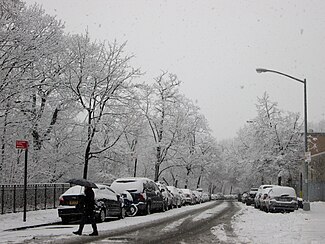
Back Hudson Heights (New York City) German Hudson Heights (Manhattan) Spanish Hudson Heights Estonian Hudson Heights French Hudson Heights (Manhattan) ID Hudson Heights (Manhattan) Portuguese
Hudson Heights | |
|---|---|
 The highest point on Manhattan is in Bennett Park; the inset shows the marker seen on the lower right of the larger image | |
 | |
| Country | |
| State | |
| City | New York City |
| Borough | Manhattan |
| Population | |
| • Total | 20,000 (2010) |
| Time zone | UTC– 05:00 (Eastern) |
| • Summer (DST) | UTC– 04:00 (EDT) |
| ZIP Codes | 10033 and 10040 |

Hudson Heights is a residential neighborhood within Washington Heights in Upper Manhattan, New York City. Most residences are apartment buildings, many of which are cooperatives, and most were constructed in the 1920s through 1940s. The Art Deco style is prominent, along with Tudor Revival. Notable complexes include Hudson View Gardens and Castle Village, which were both developed by Dr. Charles V. Paterno, and were designed by George F. Pelham and his son, George F. Pelham, Jr., respectively.
The neighborhood is located on a plateau[1] on top of a bluff overlooking both the Hudson River on the west and the Broadway valley of Washington Heights on the east. Hudson Heights includes the highest natural point in Manhattan, located in Bennett Park. At 265 feet (81 m) above sea level, it is a few dozen feet lower than the torch on the Statue of Liberty.[2]
At the northern end of the neighborhood, where Cabrini Boulevard meets Fort Washington Avenue at Margaret Corbin Circle, is Fort Tryon Park, conceived by John D. Rockefeller Jr., designed by the Olmsted Brothers, and given to the city by Rockefeller in 1931.[3] The park contains within it The Cloisters – also conceived of by Rockefeller – which houses the Medieval art collection of the Metropolitan Museum of Art.
- ^ Orenstein, Sidney (February 27, 2017) "The Geology of Northern Manhattan" (lecture)
- ^ "Bennett Park" New York City Parks and Recreation Department website. Retrieved June 22, 2010.
- ^ Kuhn, Jonathan. "Fort Tryon Park" in Jackson, Kenneth T., ed. (2010). The Encyclopedia of New York City (2nd ed.). New Haven: Yale University Press. p. 473. ISBN 978-0-300-11465-2.